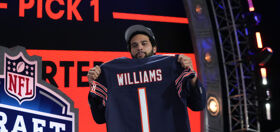
From Lady Gaga‘s icon status, to Bradley Cooper’s hotness (and prior gay performances in movies such as Wet Hot American Summer), to the drag queens like Willam who feature prominently in the opening scenes, there are lots of reasons to be excited about A Star Is Born.
But what many may not know is that the new A Star Is Born is just the latest in a long line of versions of the same story, each with their own particular significance to us LGBTs. Check out the list below to see the long, winding journey that brought us to the latest film.
A Star is Born is in theaters October 5.
1. What Price, Hollywood? (1932)
How about we take this to the next level?
Our newsletter is like a refreshing cocktail (or mocktail) of LGBTQ+ entertainment and pop culture, served up with a side of eye-candy.

What Price, Hollywood? was produced right before the implementation of the Hays Code in the early 1930’s, after which films weren’t allowed to explore topics that were deemed “inappropriate” or “controversial” by cultural conservatives, including homosexuality. The film was directed by George Cukor, the prolific gay director who directed Wizard of Oz with Judy Garland, who he would go on to direct in the 1954 version of A Star Is Born (more on that later).
2. A Star Is Born (1937)

One of the first motion pictures shot in Technicolor, it is a loose remake of the 1932 film. It starred Janet Gaynor, who for many years was rumored to be a lesbian. She was married several times, including in 1939 to Gilbert Adrian who was an openly gay costume designer at MGM. Their marriage was often termed what at the time was known as a “lavender marriage.” It also doesn’t hurt that Frederic March was one of the great heartthrobs of the Golden Era; his handsomeness and charisma still shines through to this day.
3. A Star Is Born (1954)

Arguably the “gayest” of all 5 versions, it starred Judy Garland who is considered by many to be the ultimate gay idol- for her role as Dorothy in Wizard of Oz to so many other iconic films for our community, to her untimely death that many credit as sparking the rage that led to the Stonewall Riots. It was directed, as mentioned earlier, by the gay Hollywood powerhouse George Cukor, with music by George Arlen and Ira Gershwin (the writers of many gay musical favorites), and co-starring James Mason (who just happens to be my grandfather!). Mason delivered Judy’s eulogy in New York in June 1969. Lorna Luft, Judy’s daughter, just released a great new book on the making of the film entitled A Star Is Born: Judy Garland & The Film That Got Away.
4. A Star Is Born (1976)

This version is pretty gay as well, if only for one main reason: Barbra Streisand. Judy performed with Barbra on her TV show in 1964, and unknowingly passed the baton to a new generation. Streisand personally shepherded this version from start to finish, and it’s quite different from all the other versions. It’s very over the top melodramatic, which makes it very entertaining to watch, but that doesn’t take away from Barbra’s talent or the fact that Evergreen, one of the main songs from the film, won the Academy Award for Best Original Song in 1977.


















Rugby8
I love all the versions, and am gay, but to say Star is us Born is one of the gayest movies of all time because Judy and Barbra were in each in a version is……sorta silly……lol
…..kinda makes this a basically pointless article
?
Rugby8
I love all the versions, and am gay, but to say Star is Born is one of the gayest movies of all time because Judy and Barbra were in each in a version is……sorta silly……lol
…..kinda makes this a basically pointless article…lolol
eddiesocket
Once upon a time, when there were no gay characters or gay stories told in Hollywood, it made a certain kind of sense to refer to a movie as “gay” if it had an actress in it that gay men liked. But now, in 2018, referring to a movie about a heterosexual love story with nary a gay character in sight as “the gayest movie of all time” comes off as pretty pathetic. Even this new version only has gay characters as window dressing. There’s nothing wrong with that, but don’t call it a gay movie. That’s just sad.
russdog
I am pleasantly shocked that a Queerty article is the only one I’ve read so far to correctly name What Price Hollywood? as the first version of A Star is Born. I’ve been disappointed with the reviews from people who are paid to write about movies that suggest a lack of film knowledge. The 1932 film isn’t well known and it’s no surprise the general public doesn’t connect it with A Star is Born, but film reviewers should know and provide the missing details. George Cukor was an openly gay man during a dangerous time in Hollywood and survived on talent and ability to get great performances from actresses. He was often referred to (sometimes with derision) as a “women’s director”. It’s possible that the original storyline may have been a nuanced attempt at gay subtext. The “star” and her mentor didn’t explicitly have a romantic relationship; he was possibly using her as a beard. I’ve always found the original version more fascinating from that angle, and more tragic. The way it’s directed, it’s easy to see Lowell Sherman’s character as a deeply closeted or struggling man who couldn’t keep his demons in check. He was heartbreaking as he became more desperate and dependent during his collapse as she rose in fame. George Cukor made many women-centric (code for gay) films and even began to direct Gone With the Wind until Clark Gable threw a fit about being directed by a pansy and had him fired.